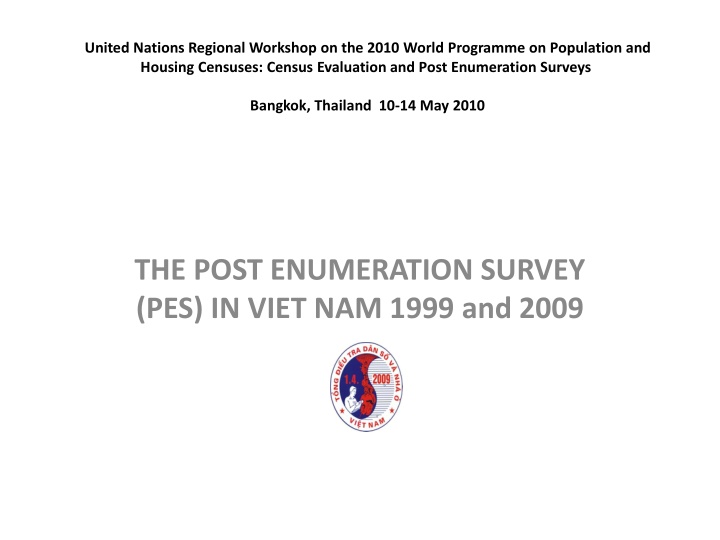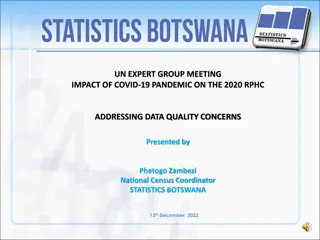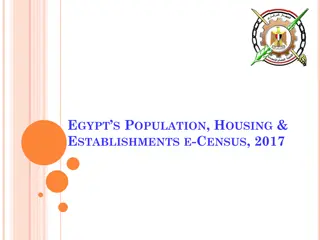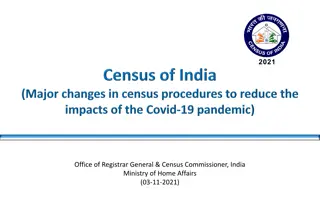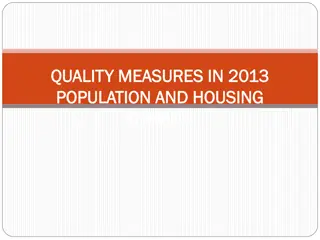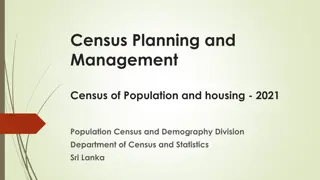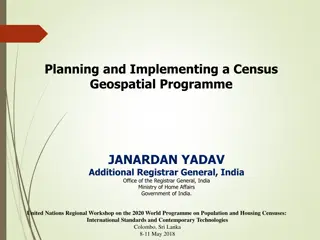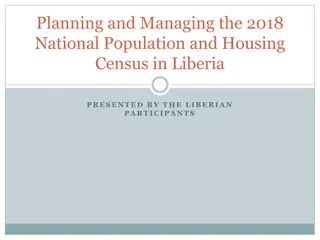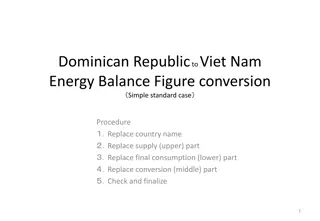Post Enumeration Survey (PES) in Viet Nam 1999: Evaluation of Census Coverage
The Post Enumeration Survey (PES) conducted in Viet Nam in 1999 aimed to evaluate census coverage by matching individual census records with PES records. The survey focused on assessing the completeness of census data to inform accuracy and aid in improving future censuses. PES teams were assembled shortly after the main fieldwork, with a dual system approach implemented to estimate errors. Independence between census and PES enumerations was maintained, ensuring reliable results for urban and rural areas.
Download Presentation

Please find below an Image/Link to download the presentation.
The content on the website is provided AS IS for your information and personal use only. It may not be sold, licensed, or shared on other websites without obtaining consent from the author.If you encounter any issues during the download, it is possible that the publisher has removed the file from their server.
You are allowed to download the files provided on this website for personal or commercial use, subject to the condition that they are used lawfully. All files are the property of their respective owners.
The content on the website is provided AS IS for your information and personal use only. It may not be sold, licensed, or shared on other websites without obtaining consent from the author.
E N D
Presentation Transcript
United Nations Regional Workshop on the 2010 World Programme on Population and Housing Censuses: Census Evaluation and Post Enumeration Surveys Bangkok, Thailand 10-14 May 2010 THE POST ENUMERATION SURVEY (PES) IN VIET NAM 1999 and 2009
THE POST ENUMERATION SURVEY (PES) IN VIET NAM 1999 The PES was a small survey undertaken shortly after the census. An important feature operation in which individual census records were matched against the individual records of the PES to evaluate census coverage. The main objective of the PES was to obtain measures of the completeness of census coverage for two principal purposes. One is to inform users of the census data about the accuracy attached to the census figures; the other is to aid census officials in the improvement of subsequent censuses. was the matching
THE POST ENUMERATION SURVEY (PES) IN VIET NAM 1999 The aim of the PES is to conducted it as soon after the completion of the main fieldwork as possible to reduce changes in household composition to a minimum. In practice PES fieldwork was conducted from 16 17 April 1999, within a week of completing the main fieldwork. The provincial census officers were instructed to recruit high quality district and provincial census staff to form the PES teams. One PES team contains 5 persons: 1 leader, 3 interviewers and 1 driver The leader of PES team was a staff member of provincial census office, who have skills and experience on annual demography survey and He was the good teacher in the training course for district census officers . 3 interviewers of PES team were recruited from the district level, where EA was selected for PES. The PES team was different from the census team Statistics Office at
THE POST ENUMERATION SURVEY (PES) IN VIET NAM 1999 110 enumeration areas among total number of EA s: 166330 ( 0.07 %). 60 EA s were selected systematic random from the list of 37384 EA s in urban areas. 50 EA s were selected systematic random from the list of 128946 EA s in rural areas. The overall size is small but permits an estimation of errors for the country and separately for urban and rural areas. The dual system approach was adopted to estimate coverage. The main features of this approach are the maintenance of independence of census and PES enumerations, and case by case matching of the census and PES records. A special PES form was designed seeking restricted details from household members to check against the main census forms. However, to maintain independence the PES teams had no access to the completed census forms.
THE POST ENUMERATION SURVEY (PES) IN VIET NAM 1999 In the 1999 census, the task of matching the census and PES forms to obtain an estimate of coverage error is complex, but provides useful results. [based on 4 questions: (1) Full name of usual resident person at the time of the census; (2) Relationship with the head of household; (3) sex ; (4) month and year of birth or age]. We collected 3 measures: * M -The number of persons were recorded in both census and PES forms * n1 The number of persons were recorded in census form only, not recorded in PES forms * n2 The number of persons were recorded in PES form only, not recorded in census forms Using the Chandrakaran Deming formula to calculate n : => n The number of persons were missed in both census and PES: n = n1*n2/M
THE POST ENUMERATION SURVEY (PES) IN VIET NAM 1999 Estimated persons missed in census and PES 1999 persons Coverage status -The number of persons were recorded in both census and PES forms 42,535 - The number of persons were recorded in census form only, not recorded in PES forms 485 - The number of persons were recorded in PES form only, not recorded in census forms 552 The PES suggest that overall about 1.3 percent of the population were missed in the 1999 census. (see page 24, 1999 population and housing census: Sample Results book, The World Publishers, Ha Noi, 2000)
THE POST ENUMERATION SURVEY (PES) IN VIET NAM 2009 * Census time: 0h, April 01, 2009 . Duration of the main fieldwork: from 1 15 April * PES time: 0h, April 01, 2009. Duration of the PES fieldwork : from 5 30 May, 2009
THE POST ENUMERATION SURVEY (PES) IN VIET NAM 2009 After finishing enumeration, post enumeration survey (PES) were conducted to define the completeness and accuracy of the census data. A set of 60 EA s were randomly selected for re-interview which was directly organized and conducted by the Office of the Central Population and Housing Census Steering Committee. The Office of the Central Population and Housing Census Steering Committee established 6 PES teams, one PES team for one region. Each PES team contains 5 persons: The team leader was selected from the department of population and labor statistics 3 interviewers were selected from Provincial census office and 1 driver from General Statistics Office, included .
THE POST ENUMERATION SURVEY (PES) IN VIET NAM 2009 In the PES, to define the completeness of the census, each usual household member was asked 4 questions: (1) full name; (2) Relationship with the head of household; (3) sex ; (4) month and year of birth or age. The responses of the PES have been compared with the census questionnaires to find data missing in the census enumeration or in the PES. We consider that the PES result is the completeness result, hence: the PES result shows both the under- count rate and over count rate.
THE POST ENUMERATION SURVEY (PES) IN VIET NAM 2009 We collected 4 measures: * N1 -The total number of persons were recorded in census form. * N2 -The total number of persons were recorded in PES form (It is a very exact record). * n1 The number of persons were recorded in census form only, not recorded in PES forms. That is the number of persons of over count * n2 The number of persons were recorded in PES form only, not recorded in census forms. That is the number of persons of under count .
THE POST ENUMERATION SURVEY (PES) IN VIET NAM 2009 The PES result of 2009 census in Viet Nam shows that the error rate is 0.3% (under count rate minus over count rate), Equivalent to about 258,000 people ) Net error (undercount rate over count rate) Regions Over count rate (%) Under count rate (%) Whole country 1.8 2.7 2.8 1.1 1.5 0.7 1.8 1.5 2.0 2.1 0.9 2.0 0.8 1.6 -0.3 -0.7 -0.7 -0.2 0.5 0.1 -0.2 1.Northern Midlands and Mountain Areas 2. Red River Delta 3.North Central Area and Central Coastal Area 4.Central Highlands 5.South East 6. MeKong River Delta
United Nations Regional Workshop on the 2010 World Programme on Population and Housing Censuses: Census Evaluation and Post Enumeration Surveys Bangkok, Thailand 10-14 May 2010 Thank you very much
